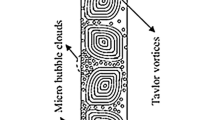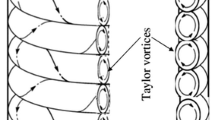Abstract
A numerical simulation is carried out to make investigation of bubbles interactions when injected in Taylor–Couette system. This process can affect the flow patterns, especially when it is combined with inner cylinder cross-section oscillations. The included phase is modeled by the Lagrangian approach. The flow regime range is considered until the onset of the wavy Taylor vortex flow (low regime). We attempt to characterize bubbles dispersion effects on the drag force near the inner-cylinder while it is executing radial sinusoidal deformations. It is assumed that the obtained configurations of air-bubbles accumulations are compared for validation with experimental and numerical studies from the literature. The bubbles have uniform spherical shape with a diameter Db = 0.06d, where d is the system gap width. The inner cylinder oscillation is imposed using a sinusoidal law with a fixed deforming frequency and different amplitude ratios of the initial radius R1. Overall, without reaching a fully developed regime, the obtained results for a low Taylor number showed that the drag reduction ratio could be decreased when the inner cylinder is deformed.

















Similar content being viewed by others
Abbreviations
- R 2, R 1 :
-
Outer and inner cylinder radius
- Ω 1, Ω 2 :
-
Inner and outer cylinder angular velocities
- H f :
-
Height of working fluid
- Hc:
-
Height of cylinders
- R max :
-
Limit of the oscillating cylinder
- R(t):
-
Instantaneous radius
- Tac :
-
Critical Taylor number
- Ta = Re\(\sqrt {\delta}\) :
-
Taylor number
- d = R 2 –R 1 :
-
Annular gap
- \(\overline{\overline{\tau }}\) :
-
Stress tensor
- r, θ, z :
-
Cylindrical coordinates
- Re = \(\frac{{\Omega_{1} .R_{1} .d}}{\upsilon }\) :
-
Reynolds number
- T :
-
Cycle of deformation
- d i, d f :
-
Initial and final annular variable gap
- f :
-
Frequency
- U TV :
-
Axial Taylor vortices velocity
- \(e_{{\text{n}}} , e_{{\text{t}}}\) :
-
Normal and tangential restitution coefficients
- ρ :
-
Density
- Γ = \(\frac{{H_{{\text{f}}} }}{d}\) :
-
Aspect ratio
- \(\eta\) = \(\frac{{R_{1} }}{{R_{2} }}\) :
-
Ratio of the radii
- \(\delta\) = \(\frac{{R_{1} }}{d}\) :
-
Gap ratio
- α :
-
Volume fraction
- ε = \(\frac{{R_{{{\text{max}}}} - R_{1} }}{{R_{1} }}\) :
-
Oscillating amplitude
- C ws :
-
Wall shear stress
- Cv:
-
Cell volume
- H, C :
-
Dimensionless parameters
- R b :
-
Bubble radius
- U f :
-
Fluid velocity
- R b, D b :
-
Bubble radius and diameter
- \(\nu_{{\text{b}}}\) :
-
Bubble volume
- V b :
-
Bubble velocity rise
- Q b :
-
Flow rate injection
- C D, C L :
-
Drag and lift coefficients of bubbles
- \(\vec{F}\) :
-
External body forces
References
Ceccio SL (2010) Friction drag reduction of external flows with bubble and gas injection. Annu Rev Fluid Mech 42:183–203
Xu J, Maxey MR, Karniadakis GE (2002) Numerical simulation of turbulent drag reduction using micro-bubbles. J Fluid Mech 468:271–281
Kodama Y, Kakugawa A, Takahashi T, Kawashima H (2000) Experimental study on microbubbles and their applicability to ships for skin friction reduction. Int J Heat Fluid Flow 21:582–588
Murai Y, Fukuda H, Oishi Y, Kodama Y, Yamamoto F (2007) Skin friction reduction by large air bubbles in a horizontal channel flow. Intl J Multiphase Flow 33(2):147–163
Dabiri S, Lu J, Tryggvason G (2013) Transition between regimes of a vertical channel bubbly up flow due to bubble deformability. Phys Fluids 25(10):102110
Park HJ, Tasaka Y, Oishi Y, Murai Y (2015) Drag reduction promoted by repetitive bubble injection in turbulent channel flows. Intl J Multiphase Flow 75:12–25
Djeridi H, Fave JF, Billard JY, Fruman DH (1999) Bubble capture and migration in Couette-Taylor flow. Exp Fluids 26:233–239
Djeridi H, Gabillet C, Billard JY (2004) Two-phase Couette-Taylor flow: Arrangement of the dispersed phase and effects on the flow structures. Phys Fluids 16(1):128–139
Murai Y, Oiwa H, Takeda Y (2005) Bubble behavior in a vertical Taylor–Couette flow. J Phys 143–156
Climent E, Simonnet M, Magnaudet J (2007) Preferential accumulation of bubbles in Couette–Taylor flow patterns. Phys Fluids 19:083301
Nemri M, Charton S, Climent E (2015) Mixing and axial dispersion in Taylor–Couette flows: the effect of the flow regime. Chem Eng Sci S0009–2509(15):00644–00652
Sugiyama K, Calzavarini E, Lohse D (2008) Microbubbly drag reduction in Taylor–Couette flow in the wavy vortex regime. J Fluid Mech 608:21–41
Chouippe A, Climent E, Legendre D, Gabillet C (2014) Numerical simulation of bubble dispersion in turbulent Taylor–Couette flow. Phys Fluids 26:043304
Spandan V, Ostilla-Monico R, Verzicco R, Lohse D (2016) Drag reduction in numerical two-phaseTaylor–Couette turbulence using an Euler-Lagrange approach. J Fluid Mech 1510(01107):v2
van den Berg TH, Luther S, Lathrop DP, Lohse D (2005) Drag reduction in bubbly Taylor–Couette turbulence. Phys Rev Lett 94:044501
Murai Y, Oiwa H, Takeda Y (2008) Frictional drag reduction in bubbly Couette–Taylor flow. Phys Fluids 20:034101
Mehel A, Gabillet C, Djeridi H (2007) Analysis of the flow patterns modifications in a bubbly Couette–Taylor flow. Phys Fluids 19:118101
Fokoua NG, Gabillet C, Aubert A, Colin C (2015) Effect of bubble’s arrangement on the viscous torque in bubbly Taylor–Couette flow. Phys Fluids 27:034105
Maryami R, Farahat S, Javad MP, Mayam S (2015) Frictional drag reduction using small bubbles in a Couette–Taylor flow. J Mar Sci Technol 20:652–669
Verschoof RA, Bakhuis D, Bullee PA, Huisman SG, Sun C, Lohse D (2018) Air cavities at the inner cylinder of turbulent Taylor–Couette flow. Int J Multiph Flow IJMF 105:264–273
Verschoof RA, Bakhuis D, Bullee PA, Huisman SG, Sun C, Lohse D (2018) The influence of wall roughness on bubble drag reduction in Taylor–Couette turbulence. J Fluid Mech 851:436–446
van Gils DPM, Narezo Guzman D, Sun C, Lohse D (2013) The importance of bubble deformability for strong drag reduction in bubbly turbulent Taylor–Couette flow. J Fluid Mech 722:317–347
Abdelali A, Oualli H, Rahmani A, Merzkane B, Bouabdallah A (2019) Experiment and numerical simulation of Taylor–Couettef low controlled by oscillations of inner cylinder cross-section. J Braz Soc Mech Sci Eng 41:259
Legendre D, Colin C, Fabre J, Magnaudet J (1999) Influence of gravity upon the bubble distribution in a turbulent pipeflow: comparison between numerical simulations and experimental data. J Chim Phys 96(6):951–957
Bouabdallah A (1980) Instabilités et turbulence dans l’écoulement de Taylor–Couette. PhD Thesis INPL Nancy France
Majji MV, Morris JF (2018) Inertial migration of particles in Taylor-Couette flows. Phys Fluids 30:033303
Oualli H, Mekadem M, Lebbi M, Bouabdallah A (2015) Taylor–Couette flow control by amplitude variation of the inner cylinder cross-section oscillation. Eur Phys J Appl Phys 71:11102
Spandan V, Verzicco R, Lohse D (2018) Physical mechanisms governing drag reduction in turbulent Taylor–Couettef low with finite-size deformable bubbles. J Fluid Mech 849:R3
Merbold S, Froitzheim A, Egbers C (2018) Torque in turbulent Taylor–Couette flow for smallradius ratios. In: 5th international conference on experimental fluid mechanics ICEFM Munich Germany, July 2–4
Mayam MHS, Maryami R, Ghafurian MM (2018) Investigation of the effect of small bubbles on energy dissipation in a vertical Couette–Taylor system. J Braz Soc Mech Sci Eng 40:244
Funding
No founding for this study.
Author information
Authors and Affiliations
Corresponding author
Ethics declarations
Conflict of interest
The authors declare that they have no conflict of interest.
Additional information
Technical Editor: Erick Franklin.
Publisher's Note
Springer Nature remains neutral with regard to jurisdictional claims in published maps and institutional affiliations.
Rights and permissions
About this article
Cite this article
Abdelali, A., Oualli, H., Hanchi, S. et al. Bubbles injection effect on Taylor–Couette flow controlled by deformations of inner cylinder cross-section. J Braz. Soc. Mech. Sci. Eng. 43, 214 (2021). https://doi.org/10.1007/s40430-021-02930-9
Received:
Accepted:
Published:
DOI: https://doi.org/10.1007/s40430-021-02930-9




